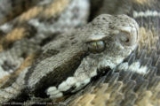
Vipera albizona
Encyclopedia
- Common names: central Turkish mountain viper.
Vipera albizona is a venomous
Venomous snake
"Poisonous snake" redirects here. For true poisonous snakes, see Rhabdophis.Venomous snakes are snakes which have venom glands and specialized teeth for the injection of venom...
viper
Viperinae
The Viperinae, or viperines, are a subfamily of venomous vipers found in Europe, Asia and Africa. They are distinguished by their lack of the heat-sensing pit organs that characterize their sister group, the Crotalinae. Currently, 12 genera and 66 species are recognized...
species
Species
In biology, a species is one of the basic units of biological classification and a taxonomic rank. A species is often defined as a group of organisms capable of interbreeding and producing fertile offspring. While in many cases this definition is adequate, more precise or differing measures are...
endemic to the mountainous regions of central Turkey
Turkey
Turkey , known officially as the Republic of Turkey , is a Eurasian country located in Western Asia and in East Thrace in Southeastern Europe...
. No subspecies are currently recognized.
Description
The maximum is a little less than 78 cm (for a male), although most specimens are smaller.
Temporal scales
In reptiles, the temporal scales are those scales on the side of the head between the parietal scales and the supralabial scales, and behind the postocular scales.There are two types of temporal scales:...
are keeled.
Midbody there are 23 rows of keeled dorsal scales
Dorsal scales
In snakes, the dorsal scales are the longitudinal series of plates that encircle the body, but do not include the ventral scales.When counting dorsal scales, numbers are often given for three points along the body, for example 19:21:17...
. There are 2-3 preventral scales
Preventral scales
Preventral scales are positioned anterior to the ventral scales and are wider than they are long, but do not come into contact with the paraventral row of dorsal scales on either side of the body....
, followed by 149-155 ventrals. The anal scale
Anal scale
In snakes, the anal scale is the scale just in front of and covering the cloacal opening. This scale can be either single or paired . When paired, the division is oblique. It is preceded by the ventral scales and followed by the subcaudal scales....
is single and followed by 23-30 paired subcaudals.
The color pattern consists of a grayish ground color. Running along the midline from the back of the head to the tail is a series of about 30 transversed and pronounced white- and black-edged narrow bands separated by a brick-red brown zone 3-4 scales long and 9-12 scales wide. Lateral spots may be small and in a double series. There are usually two large black, oblique spots on top of the head, as well as a dark stripe running from the corner of the eye back to the angle of the mouth or beyond. The belly is grayish and finely speckled with darker spots.
Geographic range
Central TurkeyTurkey
Turkey , known officially as the Republic of Turkey , is a Eurasian country located in Western Asia and in East Thrace in Southeastern Europe...
. The type locality given is "from the regions of the Kulmac Daglari mountain range, central Turkey, close to the Anatolia
Anatolia
Anatolia is a geographic and historical term denoting the westernmost protrusion of Asia, comprising the majority of the Republic of Turkey...
n 'Diagonal'".
Conservation status
This species is classified as Endangered (EN) according to the IUCN Red List of Threatened Species with the following criteria: B1+2e, C2a (v2.3, 1994). This indicates that the extent of its occurrence is estimated to be less than 5,000 km² or the area of its occupancy is estimated to be less than 500 km². Estimates also indicate that the populations are severely fragmented or known to exist at no more than five locations, and that a continuing decline is inferred, observed or projected, in the number of mature individuals. In addition, the total population is estimated to number less than 2,500 mature individuals with no subpopulation containing more than 250 such specimens. Year assessed: 1996.It is also listed as a strictly protected species (Appendix II) under the Berne Convention
Convention on the Conservation of European Wildlife and Natural Habitats
The Bern Convention on the Conservation of European Wildlife and Natural Habitats 1979, also known as the Bern Convention , came into force on June 1, 1982....
.
Taxonomy
After Nilson et al. (1990) first described V. albizona as a separate species that is parapatric with V. xanthinaVipera xanthina
Vipera xanthina is a venomous viper species found in northeastern Greece and Turkey, as well as certain islands in the Aegean Sea. No subspecies are currently recognized.-Description:...
, a group of opponents led by Schätti soon argued that V. albizona, V. wagneri
Vipera wagneri
Vipera wagneri is a venomous viper species found in eastern Turkey and northwest Iran. No subspecies are currently recognized.-Description: Grows to a maximum length of 70-95 cm....
and V. bulgardaghica
Vipera bulgardaghica
Vipera bulgardaghica is a venomous viper species endemic in the mountains of southern Turkey. No subspecies are currently recognized.-Geographic range:The Bulgar Dagh mountains, Nigde Province, south central Anatolia, Turkey...
were more likely conspecific, belonging to the polymorphic
Polymorphism (biology)
Polymorphism in biology occurs when two or more clearly different phenotypes exist in the same population of a species — in other words, the occurrence of more than one form or morph...
species, V. xanthina. According to Bettex (1993), it was also difficult to tell V. albizona from V. wagneri based on color pattern alone. However, a study published by Mulder (1994) came out in support of Nilson et al. (1990) and asserted that the color pattern of V. albizona is actually quite distinct from that of V. wagneri.

